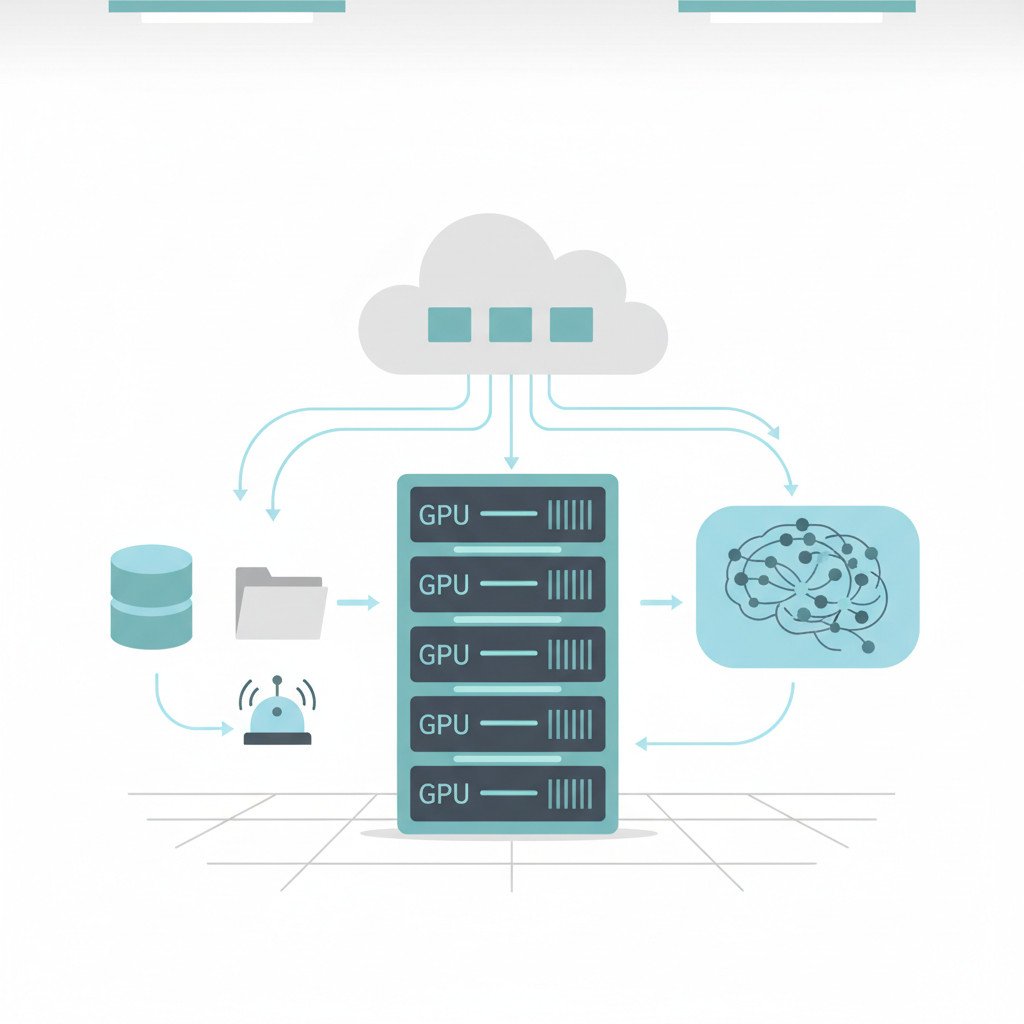Enterprise AI infrastructure: Scaling AI for modern business
Enterprise AI infrastructure now underpins how companies extract value from models. Because model sizes and data volumes soar, architecture must scale reliably and securely. It requires GPUs, efficient storage, resilient networks, and power aware data centre design.
Across industries, leaders invest in GPUs, networking fabrics, and database-native AI services. However, aligning compute, pipelines, and governance with business goals remains the hardest task. Therefore, hybrid strategies and cloud-integrated stacks often deliver the best balance of cost and control.
This article maps the core components of Enterprise AI infrastructure and their business impact. You will find practical guidance on procurement, integration, and operational maturity, with examples. As a result, technical and executive teams can prioritise investments that accelerate AI-led growth. We also examine emerging trends like agentic AI, Spectrum-X networking, and zettaflops compute. Finally, we spotlight vendor approaches from Oracle, NVIDIA, Meta, and Salesforce. Read on for a practical roadmap and decision checklist.
Core components of Enterprise AI infrastructure
Building a resilient Enterprise AI infrastructure starts with clear layers. Each layer plays a distinct role and must interoperate. Below we break down hardware, software, data management, and model integration in practical terms.
Hardware for Enterprise AI infrastructure
- GPUs and accelerators. Because training and inference demand parallel compute, GPUs are central. For example, OCI Zettascale10 and NVIDIA MGX enable massive model training at scale.
- Storage systems. Use a mix of high IOPS flash for hot data and cost-efficient object storage for archives. This balance reduces latency and cost.
- Networking. Low-latency fabrics like Spectrum-X matter for distributed training. As a result, you get higher effective bandwidth and faster parameter syncing.
- Power and cooling. Efficient power delivery such as 800-volt DC designs reduces operating costs. Therefore plan for density and redundancy.
Software and orchestration
- Container platforms. Use Kubernetes and GPU-aware orchestration for reproducible workloads. In addition, NVIDIA AI Enterprise simplifies GPU access for developers.
- MLops and pipelines. Adopt CI/CD for models, automated testing, and drift detection. Thus teams move from prototype to production faster.
- Database-native AI. Run agentic workflows and vector search inside databases to reduce data movement. Oracle AI Database 26ai provides in-database AI features and security.
Data management and governance
- Ingest and catalog. Implement schema registries and metadata stores for data discovery. This reduces integration risk across teams.
- Security and compliance. Encrypt data in flight and at rest, and use quantum-resistant algorithms where required.
- Lineage and observability. Track data and model lineage for audits and debugging.
Integrating AI models
- Model lifecycle. Train on large datasets, validate, and deploy with canary releases. Then monitor performance continuously.
- Industry examples. In finance, low-latency inference helps fraud detection in real time. In healthcare, in-database models speed clinical decision support. In retail, vector search boosts personalised recommendations.
For deeper operational patterns and governance on agentic systems, see this practical guide on implementing agentic AI in enterprises. For strategy and executive-level metrics, explore the AI success formula for executives. To understand access and equity debates across AI, read our piece on democratizing AGI vs AI.

Image shows a simple vector illustration organizing core components: data sources feeding a central server rack with GPU modules, arrows indicating data flow to a hybrid cloud and an AI model container. The composition uses neutral blues and grays and avoids text.
Benefits and challenges of Enterprise AI infrastructure
Implementing Enterprise AI infrastructure delivers clear business value. However, it also adds technical and organisational complexity. Below we summarise the main benefits and the practical challenges leaders face.
Key benefits
- Faster insights and automation. Because models run close to data, teams get near real time predictions for decisions. For example, finance teams reduce fraud loss with low latency inference.
- Scale and performance. Modern GPU clusters and fabrics enable training of larger models. As a result, companies can pursue advanced use cases like large scale recommendation systems.
- Cost efficiency at scale. Over time, optimized GPU use and hybrid cloud strategies lower total cost of ownership. Therefore long lived AI workloads become more economical.
- Better data security and control. Running AI inside trusted platforms reduces data movement. Thus regulated industries like healthcare keep sensitive records safer while using models.
- Faster developer productivity. Integrated stacks and managed services shorten time to production. In addition, containerised toolchains standardise deployments across teams.
Main challenges
- High upfront investment. Building GPU dense clusters and efficient power systems requires capital. Therefore many firms adopt cloud or hybrid models first.
- Operational complexity. Managing storage, networking, and orchestration at scale needs specialised skills. As a result, recruiting and training become priority tasks.
- Data governance and trust. Ensuring lineage, privacy, and model explainability takes effort. For instance, clinical models need strict provenance and audit trails.
- Vendor lock in and interoperability. Proprietary accelerators and fabrics can limit flexibility. Consequently, organisations should design modular architectures.
- Energy and sustainability. Dense compute increases power consumption. Therefore teams must plan cooling and efficient power delivery to control costs.
Balancing these benefits and challenges makes Enterprise AI infrastructure a strategic choice. As a result, leaders should align technical design with clear business outcomes and measurable KPIs.
Comparing Enterprise AI infrastructure solutions
Below is a concise comparison of leading Enterprise AI infrastructure solutions. Use this table to match needs to platform strengths and trade offs.
| Solution | Scalability | Security features | Integration capabilities | Cost | Best for |
|---|---|---|---|---|---|
| Oracle OCI Zettascale10 and Oracle AI Platform | Extremely high for large models and zettaflop scale | Enterprise grade encryption, quantum resistant options, in database controls | Deep Oracle stack integration, in database agentic AI, RAPIDS for Spark | High for on prem scale; competitive in OCI | Large enterprises needing database native AI and regulated workloads |
| NVIDIA MGX plus NVIDIA AI Enterprise | Very high with modular GPU pools and MGX | Hardware accelerated crypto, secure containers, driver attestation | Strong across AI frameworks and cloud consoles | Mid to high depending on deployment | GPU centric training farms and hybrid GPU clusters |
| Google Cloud Vertex AI | Elastic cloud scale with managed services | Robust IAM, data encryption, compliance certifications | Strong MLOps tooling and open model support | Variable; pay as you go | Teams needing managed MLOps and rapid prototyping |
| Microsoft Azure AI (ND series) | High with specialised GPU instances | Enterprise security, private networking, compliance suite | Integrates with Microsoft data and BI stacks | Variable; enterprise pricing | Enterprises on Microsoft tech stacks and hybrid clouds |
| On prem hybrid custom stacks (MGX or third party) | Scalable but requires ops investment | Can be very secure with internal controls and air gapping | Flexible, but interoperability varies | High initial CAPEX; lower long term OPEX | Organisations needing full data control and predictable costs |
Use this table to shortlist platforms. Then run a proof of concept to validate performance, cost, and integration in your environment.
Conclusion
Enterprise AI infrastructure shapes how organisations convert models into measurable value. Because compute, data, and models must work as one, leaders must design integrated systems. Therefore teams should prioritise scalable GPUs, resilient networks, secure data platforms, and tight governance.
Emp0 helps companies bridge strategy and execution. In addition to advisory services, Emp0 offers AI and automation tools such as Content Engine, Marketing Funnel, Sales Automation, Retargeting Bot, and Revenue Predictions. These tools run within secure client infrastructures and connect to existing data sources. As a result, customers can automate pipelines and accelerate revenue growth.
Beyond tooling, Emp0 focuses on measurable outcomes. For example, teams use Revenue Predictions to forecast opportunities and Sales Automation to increase conversion. Moreover Content Engine and Marketing Funnel drive demand while Retargeting Bot recaptures lost leads. Together these components form AI powered growth systems that multiply revenue under strong security controls.
If you want practical guidance and ready-to-deploy solutions, explore Emp0 website and Emp0 blog for case studies and implementation guides. Visit Emp0 to learn how to start.
What is Enterprise AI infrastructure?
Enterprise AI infrastructure consists of hardware, software, and frameworks that support AI models at scale. It includes GPU clusters, storage, networking, and DEVOPS integration to enable data intensive AI workloads efficiently.
How do companies implement Enterprise AI infrastructure?
Implementation typically begins by assessing requirements, setting up GPU clusters, utilizing container orchestration like Kubernetes, and integrating with existing workflows and data management systems.
What are the key benefits of Enterprise AI infrastructure?
Key benefits include faster insights, scalability, and performance for AI models, cost efficiency at scale, enhanced data security, and increased developer productivity through managed services and tools.
What challenges do companies face with Enterprise AI infrastructure?
Common challenges include high upfront costs, operational complexity, data governance issues, vendor lock in, and energy management. Careful planning and investment in skills help mitigate these risks.
How does Emp0 support Enterprise AI infrastructure?
Emp0 provides tools like Content Engine, Marketing Funnel, and Sales Automation to integrate AI-driven growth systems while ensuring data security. These solutions help companies automate effectively and enhance revenue under secure infrastructures. Explore more on Emp0 Blog.

